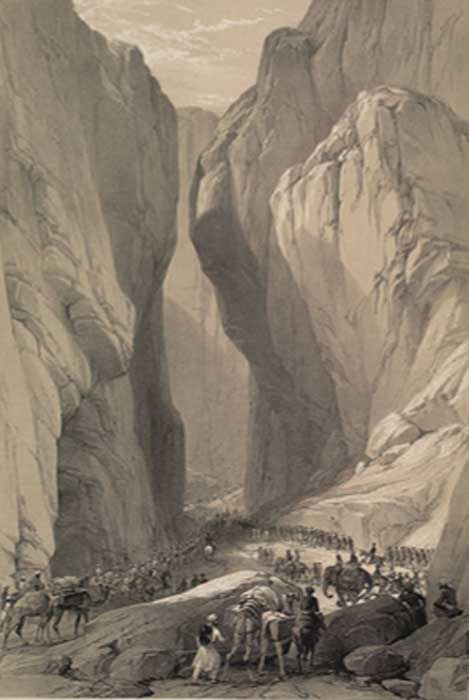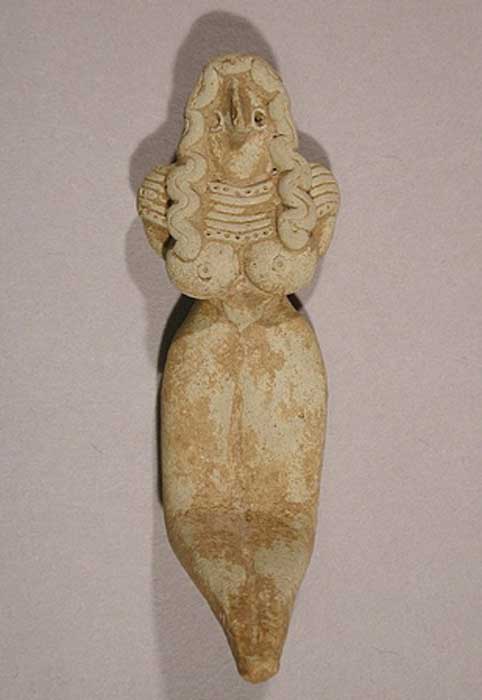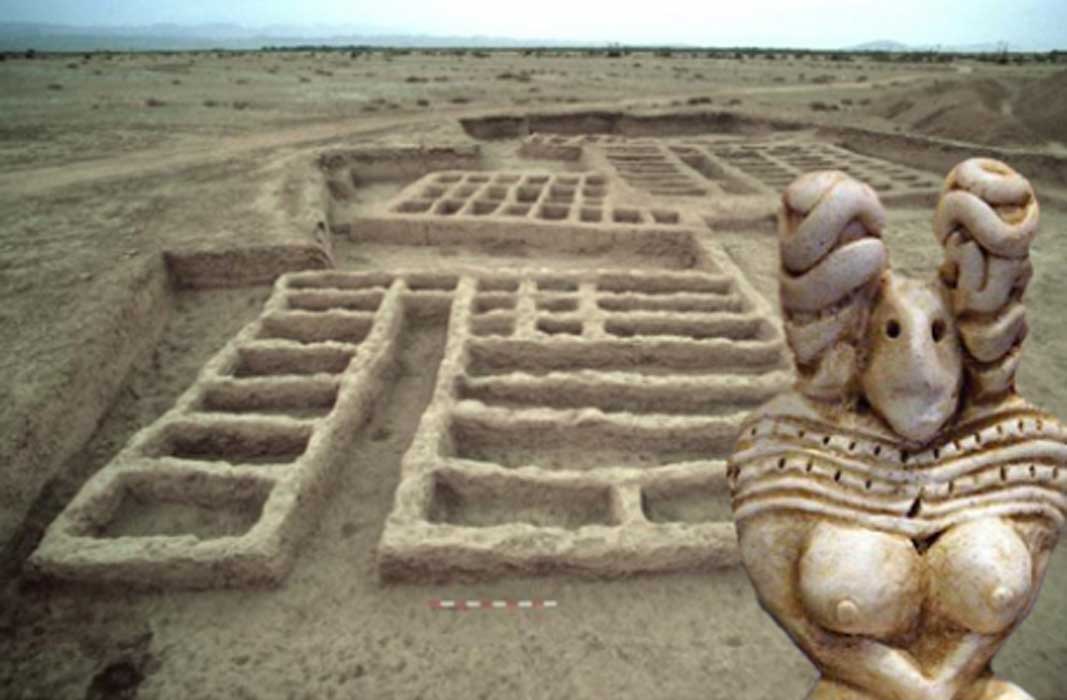A Treasure in Ruins: Ancient Mehrgarh Lost to Thieves and Violence
Mehrgarh is an archaeological site situated in the Balochistan, in the southwestern part of Pakistan. In the native Balochi language, ‘mehr’ is said to mean ‘love’, and ‘garh’ means heaven. Thus, the name of the site may be taken to mean ‘the heaven of love’.
Mehrgarh is considered one of the most important Neolithic sites in South Asia, with some of the earliest evidence of agriculture discovered there. Thus, Mehrgarh is sometimes referred to as the earliest farming settlement in South Asia. Additionally, Mehrgarh is a precursor to the Indus Valley Civilization, one of the cradles of civilization. Archaeologists have divided the occupation of Mehrgarh into seven chronological periods, which provides a picture of how the site developed over the millennia.
Passing Traders, Invaders, and Nomadic Tribes
Mehrgarh is located on the Kachi Plain, not far from the Bolan Pass, to the west of the Indus River. The Kachi Plain provides a favorable environment for human settlement due to the presence of water and arable soil, while the Bolan Pass is an important and strategic geographical feature that connects the region to the west.
- Researchers Unravel Secrets of a 6,000-Year-Old Amulet
- 1,000-Year-Old Temple in Pakistan Reopens After Seven Decades Delighting Minority Hindus

A historical sketch from 1842 of Bolan Pass, Balochistan, Pakistan. (Public Domain)
This pass is the gateway to the Indus Valley from the highlands of Afghanistan, beyond which is the Iranian Plateau and the Fertile Crescent in the Near East. In other words, it was this mountain pass that facilitated movement between the Indus Valley in the east and the other early civilizations in the west. Traders, invaders, and nomadic tribes have traversed this important pass over the millennia.
The Bolan Pass retained its strategic value well into modern times, when the British colonialists used it for their campaigns in Afghanistan. Mehrgarh lies between the modern Pakistani cities of Quetta, Kalat, and Sibi, while Mohenjo-Daro and Harappa, the two major urban centers of the Indus Valley Civilization, are located to its southeast and northeast respectively.
Discovering and Excavating Mehrgarh
Unlike Mohenjo-Daro and Harappa, the discovery of Mehrgarh occurred at a rather late date. The existence of Mohenjo-Daro was known by archaeologists as early as 1911, although excavations only began in the 1920s. Harappa was already discovered in 1826, with the first excavations taking place in 1920.
Mehrgarh, on the other hand, was only discovered in 1974. It was the French archaeologist, Jean-François Jarrige, who made this discovery. Jarrige was a specialist in South Asian archaeology, and, apart from Mehrgarh, was also responsible for the excavation of sites such as Nausharo (located about 6 km (3.73 miles) from Mehrgarh), Pirak, Sibri, Dauda Damb, Lal Shah, Damboli, and Shah Ghair.

Ruins of Mehrgarh. (M. Thoury et al./CC BY 4.0)
The site of Mehrgarh covers an area of 495 acres (200 hectares, 2 km 2). Jarrige and his team worked continuously there from 1974 to 1986. The excavations at Mehrgarh then stopped for a period of 10 years, before commencing once more in 1997. The archaeologists worked for another four years, and the campaign ended in 2000.
The excavations were carried out jointly by the French Archaeological Mission and the Department of Archaeology of Pakistan. The findings made by Jarrige and his team during their work at Mehrgarh have provided much insight into the lifestyle of the ancient people who lived there.
Mehrgarh’s Extensive Occupation History
Mehrgarh is a classic tell site, a tell being an artificial mound created over time. As the occupants of the site built new structures over the ruins of old ones, the mound gradually increased in height, and, after many generations, forms a tell. A number of these artificial mounds have been excavated at Mehrgarh, and an archaeological sequence has been formed. The sequence has been divided into seven chronological periods – Mehrgarh Period I – VII.

Ruins of Mehrgarh. (mhtoori/CC BY SA 4.0)
The earliest known settlement at Mehrgarh can be found in the site’s northeastern corner, in an area referred to as MR3. In the archaeological sequence, this period is known as Mehrgarh Period I, and has been dated to between 7000 and 5500 BC. During this phase, which corresponds to the Neolithic period, Mehrgarh was a small village that relied on farming and animal husbandry for its survival.
The culture at this point was aceramic, which means that they were not making pottery, which is one of the features distinguishing the Neolithic from preceding ages. Instead, the inhabitants of Mehrgarh were using basket containers lined with bitumen (which made the vessels water-proof). The archaeological evidence also shows that people at that time were using copper ore that was obtained locally, as well as various stone and bone tools.

A 6,000-year-old copper "wheel" amulet from Mehrgarh. (Abbas dhothar/CC BY SA 4.0)
The presence of foreign goods, seashells from distant seashores, and lapis lazuli from Afghanistan, suggests that the people of Mehrgarh were already in contact with the outside world.
During the Mehrgarh I Period, the occupants of the site lived in simple mud buildings that had four internal divisions. These houses were free-standing and rectangular in shape, while the mudbricks used for their construction have a long, cigar shape.
The form of these structures is quite similar to those found in 7th millennium BC Mesopotamia, and a connection between the two areas has been proposed. Further evidence supporting the link between Mehrgarh and Mesopotamia include the similarities in crafts, agricultural, and funerary practices.
- 13,000-Year-Old Bitumen Dental Fillings Found in Italy: Earliest Example of Dentistry Known to Date
- Are the Distinctive Kalash People of Pakistan Really Descendants of Alexander the Great’s Army?

7000 BC well in Mehrgarh. (mhtoori/CC BY SA 4.0)
Early Farmers and Dentists
Mehrgarh is also notable for having the earliest archaeological evidence of agriculture in South Asia. The people who lived during the Mehrgarh I Period had access to plant foods such as domesticated and wild six-rowed barley, domestic einkorn and emmer wheat, and wild Indian jujube ( Zizyphus spp) and date palms ( Phoenix dactylifera).
In addition, meat was being consumed at Mehrgarh. The faunal remains of herded animals, such as sheep, goat, and cattle, as well as those of wild animals, including gazelle, water buffalo, and elephant were found in this archaeological layer. The types of hunted animals suggest that during this period the area of Balochistan was dominated by savannah.
Two other exciting findings were made by archaeologists – the earliest known example of cotton in the Old World and the earliest evidence for the drilling of human teeth in vivo, i.e. in a living person. The former was published in the Journal of Archaeological Science in 2002 and the latter was published in Nature in 2006.

An experimental reconstruction of a bow and flint-tipped drill used to bore through molar teeth found at a Neolithic graveyard in Mehrgarh, Pakistan. (University of Poitiers)
The discovery of the cotton threads was made during the metallurgical study of a copper bead that came from a burial at Mehrgarh. As a result of mineralization, a few cotton threads were preserved, and therefore could be analyzed. With the aid of a scanning electron microscope (SEM) and a reflected-light microscope, the researchers were able to study the morphology of the fibers, and concluded that they were from cotton.
As for the discovery of the practice of proto-dentistry in Mehrgarh, the researchers identified a total of 11 drilled permanent crowns in nine individuals. The teeth were studied using light microscopy, SEM, and microtomography, and the results of these analyses showed the presence of conical, cylindrical, or trapezoidal cavities, as well as concentric ridges preserved on some walls.
All these are signs that the teeth had been drilled. In all cases, the researchers observed marginal smoothing of the cavity walls. This led them to the conclusion that the drilling had been done while the individuals were still alive, as they continued to chew with these teeth, hence the marginal smoothing.
Flint drill heads were part of the lithic assemblages of the site, and using experimental archaeology, the researchers found that less than a minute was needed to produce similar holes in human enamel with these tools. The researchers also postulated that the knowledge of drilling may have been first developed by artisans for the production of beads, and was later used to drill human teeth.
Ceramics and Craftworks at Mehrgarh
The next level of occupation is referred to as Mehrgarh Period II, and dates to between 5500 and 4800 BC. By this time, the people of Mehrgarh were producing ceramics. It seems that there was a shift in focus from the area of MR3 to a new one, MR4. During this period, agriculture was firmly established at the site, and the archaeologists found that locally domesticated barley (about 90%) was the main crop, though wheat from the Near East was also available to its inhabitants.

Mehrgarh painted pottery. 3000-2500 BC. (CC0)
The archaeologists also excavated a number of sun-dried brick buildings. These were large and rectangular and were divided symmetrically into smaller squares or rectangles. The archaeologists were of the opinion that these were not houses like the ones excavated in the Mehrgarh Period I layer, as they did not have doors, and there was a lack of residential remains. Instead, they suggested that these structures were either granaries, or other warehouses that were shared by the entire community.
Other structural remains found at this level indicate that large scale production of craft goods had begun in Mehrgarh. These are standardized rooms surrounded by a large open space where the craftsmen would work. This aspect of life in Neolithic Mehrgarh is also evident in the material culture left behind at the site.

Seated Mother Goddess, 3000–2500 BC. Pakistan (Baluchistan) Mehrgarh style. (CC0)
The primary product of these craftsmen were beads which are characteristic of the region. This tradition of bead making would last up until the time of the Indus Valley Civilization. During Mehrgarh Period II, craftsmen were making various types of beads. For instance, soft stone beads, such as limestone and steatite, were being made, possibly with stone or copper drills.
For harder types of stone, including agate and jasper, specialized stone drills would have been used. Marine shell ornaments were also being made in Mehrgarh. The beads and shell ornaments show that during the Mehrgarh II Period, there was an increase in the importation of non-local raw materials to the site.
This situation continued into the next period, Mehrgarh Period III, which lasted from around 4800 to 3500 BC, and is considered to be the Early Chalcolithic period. The focus of the settlement, however, shifted once more, this time to the area MR1. Like the preceding period, storage facilities and houses were unearthed by the archaeologists, though these structures were much more elaborate than their Neolithic counterparts. For instance, they had foundations of pebbles embedded in clay, and the buildings’ bricks were made with molds.
Mehrgarh Periods IV – VII lasted from about 3500 to 2500 BC and these levels belong to the Chalcolithic period. The inhabitants of the site shifted to MR1. During these periods, pottery and crafts continued to be manufactured at the site, though it is clear that there were stylistic changes.

Stylistic depictions of the Togau ware found at Mehrgarh shows how the Mehrgarh people moved towards a mass-production model for their pottery ware. (Arun Reginald/CC BY SA 4.0)
Mehrgarh is Abandoned
At the end of the Mehrgarh Period VII, the site was largely abandoned. Around the same time, the Indus Valley Civilization was in its middle stages of development. It has been hypothesized that as a result of climatic changes, the region of Balochistan had become more arid and unsuitable for agriculture. As a consequence, the people of Mehrgarh migrated to the Indus Valley, where environmental conditions were more favorable.
Despite its significance, the site of Mehrgarh is in a sorry state today. While Mehrgarh is currently on UNESCO’s Tentative Heritage List, it has been alleged that the central government has not taken the site seriously. The blame has been placed on the government’s failure to present the site to UNESCO in an effective way.
- Paleolithic Toothache: Oldest Dentistry Revealed in 14,000-Year-Old Tooth of Young Man
- Was Alexander the Great Responsible for Creating Shangri-La in the Hunza Valley in Pakistan?
Mehrgarh also faces other, more serious, problems. In 2002, the site became an unfortunate victim of a tribal feud between the Raisani and Rind tribes. Rockets fired by both tribes badly damaged the site. Additionally, although the site was under the control of the Raisani, the Rind also had claims over it. Not content with the way things were, the latter decided simply to bulldoze the site.
In addition to local problems, Mehrgarh faces international ones as well. In October 2014, the Italian authorities confiscated antiquities in Rome that were stolen from Mehrgarh. In a 2015 article, it was reported that the objects have not been repatriated yet due to bureaucratic red tape and the lack of interest from Pakistani authorities.

Archaeological Site of Mehrgarh in September 2018. (mhtoori/CC BY SA 4.0)
Although the seizure of the smuggled antiquities in Rome is commendable, it does not address the root of the problem. The illegal trade of antiquities is rampant in Pakistan and is an issue that needs to be addressed if the future of Mehrgarh and other sites is to be guaranteed.
Top Image: Ruins of Mehrgarh. (M. Thoury et al./CC BY 4.0) Insert: Detail of a female figure made of terracotta from Mehrgarh, circa 3000 BC. (Denis Biette/CC BY SA 1.0)
By Wu Mingren
References
Aamir, A., 2015. Mehrgarh. [Online]
Available at: http://balochistaninside.com/mehrgarh/
AncientPakistan.info, 2006. 7000 – 3300 B.C -Mehrgarh Culture. [Online]
Available at: http://ancientpakistan.info/pakistan-history-timeline/mehrgarh-culture/
Baloch, S. M., 2019. Pakistan’s Crumbling Cultural Heritage. [Online]
Available at: https://thediplomat.com/2019/01/pakistans-crumbling-cultural-heritage/
Coppa, A. et al., 2006. Early Neolithic tradition of dentistry. Nature, Volume 440, p. 755.
Didier, A. & Quivron, G., 2015. In Memoriam: Jean-François Jarrige. [Online]
Available at: https://www.persee.fr/doc/paleo_0153-9345_2015_num_41_1_5650
Hirst, K. K., 2019. Harappa: Capital City of the Ancient Indus Civilization. [Online]
Available at: https://www.thoughtco.com/harappa-pakistan-capital-city-171278
Hirst, K. K., 2019. Mehrgarh, Pakistan and Life in the Indus Valley Before Harappa. [Online]
Available at: https://www.thoughtco.com/mehrgarh-pakistan-life-indus-valley-171796
Meadow, R. H. & Kenoyer, J. M., 2019. Early Developments of Art, Symbol, Technology in the Indus Valley Tradition. [Online]
Available at: https://www.harappa.com/indus3/e5.html
Moulherat, C., Tengberg, M., Haquet, J.-F. & Mille, B., 2002. First Evidence of Cotton at Neolithic Mehrgarh, Pakistan: Analysis of Mineralized Fibres from a Copper Bead. Journal of Arhcaeological Science, Volume 29, pp. 1393-1401.
New World Encyclopedia, 2018. Mehrgarh. [Online]
Available at: https://www.newworldencyclopedia.org/entry/Mehrgarh
Notezai, M. A., 2017. The lost civilisation of Mehrgarh: A treasure in ruins. [Online]
Available at: https://www.dawn.com/news/1316715
Rao, S. R., 2008. Agriculture in the Indus Civilization. In: L. Gopal & V. C. Sirvastava, eds. History of Agriculture in India, Up to C. 1200 A.D.. New Delhi: Centre for Studies in Civilizations, pp. 171-202.
Roach, J., 2019. Mohenjo Daro. [Online]
Available at: https://www.nationalgeographic.com/archaeology-and-history/archaeology/m...
The Editors of Encyclopaedia Britannica, 2011. Bolān Pass. [Online]
Available at: https://www.britannica.com/place/Bolan-Pass
UNESCO, 2019. Archaeological Site of Mehrgarh. [Online]
Available at: https://whc.unesco.org/en/tentativelists/1876/




















Comments
Mehr isn't just romantic love, but unconditional love. Mehrgarh means, Heaven's Love--as in Heaven on Earth; not "the heaven of love".
The statuettes are of the aspect of Maiden & Mother, but also represent the Holy Harlots & their hairstyles of the time. Notice the Maiden with her hair down & arms behind her shy & modest. Now take note of the Mother with her arms forward, offering her bosom; her long, braided hair fashioned into horns--or disguising them. Remember in antiquity, throughout the world Mother is always depicted with horns, as this is her natural crown as Creatrix. Nowadays horns are largely diabolicalized, but that's a story for another day.
Oh & the presentation of "wheel amulet" is a bit off. Turn it so 3 triangles point up & the other 3 point down. Now draw a Yab-Yum: Two intersecting triangles one downward, the other upward forming a 6-pointed Star. The triangle pointing up represents male & the triangle pointing down represents females. The 6 triangles represents the meeting of women & men, as the Yab-Yum is an ancient symbol of love & union of the genders.✡️
I wonder if the excavators &/or archeologists noticed the vessel depicting the 3 fish; acknowledging the coming Age of Pisces.♓